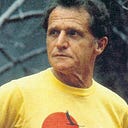The Sun Will Shine Again…
Dec. 3, 2020 — This is one of my favorite lines in 1978 version of “Run — the Lydiard Way”: “…Most of the world’s greatest athletes have had their setbacks and recovered from them…”. My wife was running pretty well; up to 2-hours over the weekend. And then a lower-back pain struck. Her father had a few back surgeries and she had been very cautious about it, doing stretching, some exercises, using a heat pad, etc…. But this one seems pretty bad and she now couldn’t run over 2 weeks; only limited to about a mile slow walk. Naturally, she’s pretty depressed and frustrated. I told her about the fellow Minnesotan runner, Garry Bjorklund.
He was one of those “tough-as-a-nail” kind of a runner. In the final few laps of 1976 Olympic Trial 10000m, he lost one of his spike shoes. One barefoot, he sprinted past the King of the Road, Bill Rodgers, to claim the third place behind Frank Shorter and Craig Virgin. Back in 2006 at the Grandma’s Marathon in Duluth, MN, Bjorklund (fondly known as “BJ”) and Dick Beardsely were supposed to have a two-men gig at the Expo. Anybody who attended Dick Beardsley’s talk can tell you; he is very emotional and, with all ups-and-downs he had in his life, he always gets tearful at the end. But in this occasion, the table was turned. This is because BJ spotted someone in the audience. It was his University of Minnesota teammate, Don Timm. BJ had a career-threatening injury while at U of M and seriously thought about just “hanging-up”. One day, there was a knock on the door. It was Don Timm. “Hey, BJ! Let’s go for a run.” “You know I can’t run,” BJ replied. “We’ll do what we can,” said Don. They took off….for a half a mile. “I can’t go any more,” said BJ. So they turned around and walked/hobbled back. Next day, same thing. They walked and hobbled a mile day after day….and gradually increased the duration. A couple of years later, he not only made the USA Olympic team, at Montreal, he was the sole American to make the final.
At the 1983 Tokyo Marathon, Japan’s legend, Toshihiko Seko, set then Japanese national marathon record of 2:08:37, winning it seemingly easily. Not too many people remember that he hadn’t run a marathon since 1981 Boston Marathon which he won. He had series of injuries plus and attack of hepatitis. Over a year, he couldn’t run. So instead, he walked — he walked up to 20-miles with rocks in hands to strengthen his upper-body. He had a persisting case of a bone spur in his knee. At one point, he recalls, he wanted to just get a knife and cut it (his knee) open to see what the heck is going on in there!! While injured, he got frustrated and drunk too much beer (!!) that eventually affected function of his liver. He was on medication and gained weight, which didn’t help his knee injury. But, as any other injury, he eventually overcame, got his fitness back that led to this record-setting marathon; followed, 10-months later, thrilling last 100m sprint to claim 1984 Olympic spot at Fukuoka Marathon, beating his arch-rivals, Soh Brothers, and then the world record holder, American’s Alberto Salazar (see the coverage — in Japanese — HERE).
In an interview with New Zealand Runner (you can read the whole interview HERE), Arthur Lydiard said: “…the man I had the most admiration for that I trained was Halberg. He came from death’s bed to be an Olympic champion…”. Murray Halberg was a very good young runner but, when he was 17, he got tackled in a rugby game and literally crushed his left shoulder. The nerves were cut; and major blood vessels were ruptured and blood started to leak around his heart. Doctors had to cut his chest open, exposing his heart, in order to remove clotting blood around his heart. Doctors asked his parents whether or not to amputate his arm. “He wouldn’t last till next week,” his parents responded, “we would like the whole body in a casket so please leave his arm…”. Their assumption was wrong. He not only survived, but also made up his mind that he would excel in athletics. The path wasn’t easy. He was born left-handed so he would have to re-learn how to write his name. He couldn’t use a knife and a fork so his family or friends would have to chop up foods for him. He then joined the Lydiard group, started training “the Lydiard Way”. It’s not easy running 100-miles-a-week. Going up a 3-mile long uphill over the famous Waiatarua loop was not easy with one arm just “hanging” there. But he persevered. He would soon become the first New Zealander to break 4-minutes for the mile and, 10 years after near-futile accident, he would claim the ultimate athletic prize; the Olympic gold medal.
Every champion has overcome injuries and some hardships. I remember what a colleague and a good friend, the late Dick Brown said: “Being serious means; you do everything you can when things are going great. It is when things are going well, you slacken and lower the guard (as an old samurai saying goes: “It’s when you had won the battle, you tighten the armors.”). But also, you do everything you can when nothing is going right. When you’re down, you get frustrated and get depressed and throw the towel. There ARE things you can do — keep doing them!!” When things are tough; don’t throw the towel, sit tight, the storm will pass and the sun will shine again. (* I did NOT tell all these stories to my wife; only the first one) — Nobby Hashizume
